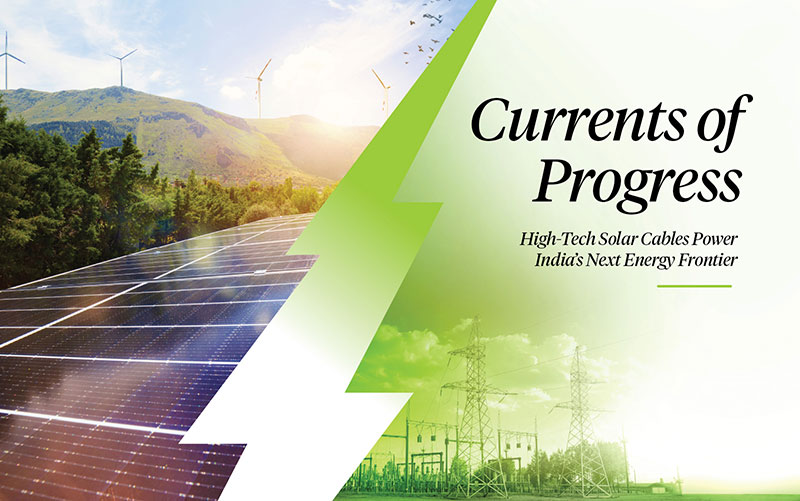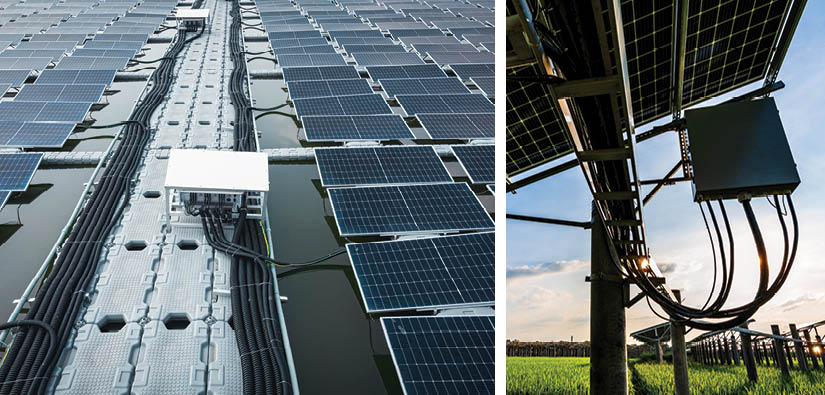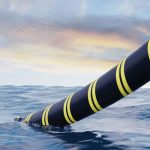As India surges ahead in its solar journey, cable manufacturers are quietly shouldering the weight of innovation, turning a humble wire into a high-performance lifeline of the green grid.

In the race toward clean energy dominance, solar panels steal the spotlight. Their sleek surfaces and sprawling installations have become visual shorthand for progress. Beneath the gleaming solar panels and precision-engineered tracking systems lies a quieter force: cables that carry the true current of India’s solar revolution. India’s solar cable manufacturers are stepping into the light, literally and metaphorically, as the backbone of the nation’s energy transition strengthens.
With solar capacity surpassing 110 GW and a 2030 target of 280 GW, the scale of deployment is unlike anything the power sector has seen. Behind each megawatt of generation lies kilometers of cabling, bearing not just electricity, but the weight of safety, durability, and long-term performance. And the rules of the game are evolving fast.
Solar Cables: Core Requirements and Voltage Classes
Not all solar installations are alike, and neither are the cables that connect them. While large-scale utility projects in India are increasingly shifting to 1.5 kV DC system architecture, a substantial portion of the market still operates at lower voltage classes such as 600 V, 1000 V, or 1100 V DC. These include rooftop systems, off-grid rural setups, and legacy commercial installations.
Regardless of voltage, solar cables are engineered to meet demanding requirements: they must be double insulated for mechanical and electrical safety, resistant to UV radiation and ozone for prolonged outdoor exposure, and capable of operating across wide temperature ranges, from –40°C to +90°C or more. In addition, they are expected to demonstrate fire retardancy, halogen-free composition, and strict compliance with standards such as IS 17293, IEC 62930, or EN 50618.
While the move to 1.5 kV systems is driven by the need to lower balance-of-system (BOS) costs and transmission losses in sprawling solar parks, lower-voltage cables continue to play a vital role in India’s diverse solar ecosystem. Manufacturers today are expected to offer a full portfolio of voltage-grade cables, optimized for both emerging technologies and existing market realities.
Watch: Top Cable Companies in India
Rewiring for 1.5 kV
As utility-scale solar farms shift to 1.5 kV DC architecture to reduce BOS costs and improve efficiency, the demands on cable performance have multiplied. For many manufacturers, this isn’t just a technical tweak; it’s a rethinking of solar cable architecture. “We have proactively re-engineered our solar cable designs to align with the shift towards 1.5 kV DC architecture,” says Anil Gupta, CMD, KEI Industries.
The evolution has seen the shift from traditional PVC-based insulation to halogen-free, cross-linked polyolefin compounds capable of withstanding high ambient temperatures, UV exposure, and thermal cycling typical of Indian solar parks.
Moreover, higher voltages bring higher stress, not only on insulation, but also on thermal aging and reliability. Indian cable makers are responding with reinforced insulation compounds, enhanced thermal class materials, and designs optimized for minimal voltage drop over long distances. “Our cables feature enhanced insulation with higher thermal endurance and improved dielectric properties. These advancements allow our products to perform reliably under higher voltages and elevated temperatures, ensuring reduced transmission losses and extended service life,” informs Anil Gupta.
RR Kabel echoes this transformation. “Our latest DC solar cables incorporate enhanced insulation and superior thermal stability, delivering exceptional long-term reliability even under high-voltage conditions,” shares Shreegopal Kabra, Promoter & President, RR Global.
The E-Beam Advantage
Enter electron beam (e-beam) cross-linking, a technology long trusted in aerospace and railways, now defining the future of solar. “Electron beam (e-beam) cross-linking is integral to KEI Industries’ solar cable manufacturing process,” says Anil Gupta.
E-beam treated cables offer superior thermal endurance. “It offers superior mechanical strength, enhanced UV and ozone resistance, and long-term thermal stability,” adds Anil Gupta.
Unlike chemical cross-linking, this process eliminates risks of under- or over-curing, ensuring consistency. “E-beam cross-linking is an essential part of the curing process for cables, specifically for solar cables which need to be exposed to atmospheric conditions throughout their life span,” informs Amit Agarwal of Orbit Cables.
Cross-linking at the molecular level alters the internal structure of polymer chains, bonding them into a tightly woven, three-dimensional network. E-beam cross-linking is no longer a premium exception. It is becoming a defining marker of cable durability and design maturity.
While e-beam infrastructure comes with a capital cost, manufacturers argue the lifetime cost-benefit ratio is a clear win, especially when project developers factor in 25-year performance warranties and the growing insistence on fire and environmental safety.
Shreegopal Kabra elaborates: “Unlike conventional methods, e-beam technology achieves crosslinking at the molecular level… Although the initial investment is higher, e-beam cables offer unparalleled longevity and cost-efficiency over the project’s lifetime.”
Floating, Hybrid, and the New Normal
India already has several large-scale floating solar plants in operation. Hybrid solar-plus-storage systems are also reshaping infrastructure demand. SECI has floated a tender for 2,000 MW of solar projects co-located with battery energy storage systems (BESS), while SJVN has awarded a 150 MW, 300 MWh solar-storage hybrid to Sembcorp, scheduled for operation within two years.
The rise of floating solar systems and hybrid solar-plus-storage plants is challenging cables to adapt not just electrically, but environmentally. These floating and hybrid installations impose new and stringent requirements on solar cables.
Manufacturers now specify anti-wicking, water-resistant sheathing, UV-stabilized insulation, and multi-layer moisture barriers tailored to prolonged submersion and high humidity. Shreegopal Kabra states: “A key differentiator in our offering is our adherence to AD8 compliance, which signifies suitability for continuous submersion in water.”
The combination of solar generation, storage electronics, and fluctuating loads also needs cables with consistent conductivity, minimal degradation under thermal cycling, and fire-rated designs even in moisture-rich environments.
Indian cable firms have begun type testing under conditions simulating 20,000 hours of immersion, mechanical load, extreme weather, and ozone exposure to meet standards such as IS 17293 and IEC 62930, even aligning to export-grade EN 50618 norms. “Our cables have been type tested for endurance over a period of 20,000 hours… subjected to various extreme stresses… such as immersion in water, mechanical stresses, extreme weather conditions,” states Amit Agarwal, reinforcing Orbit Cables’ endurance credentials.
Anil Gupta adds, “For floating solar, we provide water-resistant cables with tight sheathing, superior UV stability, and anti-wicking properties… These innovations allow our products to adapt seamlessly to the evolving solar landscape.”
Hybrid solar-plus-storage systems subject cables to dynamic load conditions, high-frequency switching, and densely packed electronics, creating thermal stress and electromagnetic interference (EMI) risks.
In such environments, effective EMI shielding is essential to ensure signal integrity, system stability, and long-term cable performance. “…our cables offer high Electromagnetic Interference (EMI) shielding to ensure stable performance in hybrid and storage-integrated systems,” says Anil Gupta.
“To address hybrid system challenges, we offer shielded cables with low transfer impedance for EMI mitigation and enhanced grounding integrity, ensuring safety in sensitive installations,” adds Shashi Amin of APAR Industries.
The Pursuit of Trust
In the high-stakes world of solar infrastructure, cable reliability is non-negotiable, and trust is built through rigorous compliance and repeatable testing. Indian manufacturers have significantly strengthened their quality frameworks to meet both domestic regulations and international benchmarks.
At the core of these efforts are standards like IS 17293, the BIS-mandated specification for solar DC cables in India, and general test methods from the IS 10810 series. RR Kabel confirms that “our solar cables are manufactured in compliance with IS 17293… tested under the protocols laid out in the IS 10810 series and relevant IEC methods.” APAR adds that its cables are BIS-certified and tested against IEC 60228, IEC 60502, and IEC 62930.
Compliance doesn’t end at domestic borders. Leading manufacturers such as KEI, APAR, Polycab, and RR Kabel routinely certify cables to EN 50618, IEC 62930, UL 4703, and TÜV 2 Pfg 1169/08.2007 specifications. APAR confirms its compliance with Construction Products Regulation (CPR) standards for Europe, while Polycab adds certifications from BASEC (British Approvals Service for Cables), CE, RoHS, and REACH. Both APAR and Polycab operate NABL-accredited labs, and the latter notes that “our NABL ISO 17025-accredited labs conduct extensive testing aligned with IS, IEC, UL, and BS standards.”
Fire safety remains a critical parameter. Cables are tested for flame retardancy under IEC 60332, halogen content under IEC 60754, and smoke density via IEC 61034. Manufacturers offer products conforming to FR, FRLS, and LSZH ratings. APAR specifies that its solar harnesses and cables undergo “comprehensive testing against IEC fire safety protocols and 25+ years of simulated lifecycle exposure including UV, moisture, and dielectric stress.”
Lifecycle validation is a common thread. All companies report accelerated aging, spark testing, high-voltage withstand, and mechanical impact resistance. Orbit Cables highlights “20,000-hour endurance simulations” and a four-tier documentation system to ensure repeatable quality. Polycab adds torsion resistance, hydrolysis tests, and UV aging per UL 1581 and ASTM 154, especially for floating and hybrid solar applications, where their “AD8-rated cables” are engineered for continuous water submersion. APAR similarly notes its compliance with EN 50525-2-21:2011 (AD8) for floating systems, and includes features like low transfer impedance shielding for EMI mitigation in storage-integrated designs.
These measures are not merely checkboxes. As global EPCs seek reliable sourcing partners beyond China, Indian cable manufacturers like APAR and Polycab report surging export interest. “There is growing demand internationally… certifications like TÜV, UL 4703, and CPR are increasingly sought after by clients across Europe, North America, and the Middle East,” states APAR.
Polycab echoes this sentiment: “There has been an increase in global demand for India-made solar cables, driven by the ‘China+1’ strategy and the global renewable energy push… Polycab has emerged as a preferred partner across the US, Europe, and Asia-Pacific.”
As India seeks to position itself as a global hub for solar cable exports, this growing alignment with global norms, and the systems that uphold them, is transforming cable manufacturing from a commodity business to a compliance-first, quality-led industry. While challenges around certification costs, talent gaps, and price-driven procurement remain, top-tier players are proving that India can effectively meet world-class benchmarks.
Material Innovation & Market
Solar cable innovation begins at the molecular level with materials that can withstand decades of heat, stress, and UV exposure while delivering uninterrupted performance. As solar parks scale in size and complexity, manufacturers are turning to advanced compounds and high-purity metals to push the boundaries of reliability. “We are witnessing the increased adoption of high-conductivity copper and halogen-free, low-smoke insulation compounds,” says Anil Gupta of KEI Industries.
RR Kabel complements this with a sharp focus on material sourcing and process optimization. “We maintain a diversified sourcing strategy and invest in ongoing R&D to enhance material efficiency while maintaining superior performance,” informs Shreegopal Kabra.
Indian solar cable manufacturers typically use electrolytic copper conforming to ASTM B-170 for high conductivity, and IS 8130 for domestic compliance with conductor standards as mandated under BIS.
For cable manufacturers operating in humid, high-UV, or chemically corrosive regions, compound formulation is critical. Polycab highlights its use of electron-beam crosslinked insulation, high-performance thermoset compounds like XLPO and EPR, and hydrolysis-resistant sheathing designed for long-term durability in humid, coastal, and high-temperature solar installations.
As solar demand accelerates across continents, Indian manufacturers are making strong strides into export markets. “There is a strong and growing interest from global EPCs in Indian-manufactured solar cables…Our ability to meet these stringent global benchmarks…has made KEI Industries a preferred partner for solar infrastructure across borders,” notes Anil Gupta.
Amit Agarwal agrees: “…with the metal pricing being made compatible with London Metal Exchange (LME), and other government policies have helped Indian manufacturers to compete in the international market at par with international competition.”
But export readiness is not only about compliance; it’s about supply resilience, documentation, and support infrastructure. RR Kabel emphasizes that what sets them apart is not just compliance, but a comprehensive approach that includes “performance documentation, warranty support, traceability, and life cycle assessment,” all of which are critical, especially for utility-scale solar exports.
From conductor to compound, Indian solar cable makers are evolving into global-grade solution providers balancing performance and compliance, while endeavoring to attain cost efficiency with a strong foundation in material science and scalable manufacturing.
Also Read: KEI Industries Powering India’s Renewable Energy Infrastructure
The Challenges Within
While India’s solar cable industry is rapidly evolving, it is not without its set of structural and operational constraints. Shreegopal Kabra cautions that the ecosystem still wrestles with some hard realities: “The key challenges include the rising costs and complexity of obtaining multiple certifications, a limited pool of skilled labour, and the persistence of price-driven procurement mindsets.” These intertwined issues hamper both agility and quality advancement.
Adding to this, Amit Agarwal flags the high cost and limited availability of electron-beam accelerators as a critical infrastructure gap. “…there are a lot of checks and controls from the government in installing an e-beam accelerator. It practically takes two years or more to procure and install the e-beam system,” he informs. He is of the opinion that “government agencies or private manufacturers” should take the initiative to produce e-beam accelerators “in the country.” This would help lower investment costs for cable manufacturers and significantly reduce the time required to establish production facilities.
Amit Agarwal also expresses concern over unregulated players in the domestic market, warning that “major challenges in solar cable manufacturing are from unorganized sector manufacturers who misguide and dole out sub-standard material without any control from the certification and standards body.”
APAR’s Shashi Amin too echoes several of these challenges in the solar cable landscape. The company points to “significant costs and lead times associated with certifications like TÜV, UL, and CPR,” which slow down market access. He also flags “commoditisation and quality compromises” driven by price-sensitive procurement trends. Additionally, he underlines persistent “skilled workforce shortages,” which complicates the adoption of evolving technologies such as e-beam crosslinking and halogen-free compounds.
Polycab brings attention to a different facet of risk: quality dilution through aggressive cost bidding. It warns that an aggressive focus on lowest-cost bidding, especially in tenders, often results in “compromised quality,” with non-compliant cables being “mislabelled with BIS/TÜV/UL logos.”
Polycab also cites delays and costs associated with meeting export-grade norms: “Expensive third-party audits, recurring costs and long lead times for global certifications such as UL, EN 50618, and TÜV also pose barriers.” On the shop floor, there’s another layer of challenge: “…there is a skills gap in areas like polymer compounding, quality testing, and precision manufacturing, particularly for advanced processes like e-beam cross-linking.”
KEI’s Anil Gupta affirms several of these concerns, pointing to the broader landscape of hurdles: “The industry faces challenges like high certification costs, unorganized sector competition, and price-sensitive procurement trends.” The company also underlines the need for state support: “We also advocate for policy-level incentives to promote ‘Make-In-India’ products that adhere to quality standards, thus contributing to a robust manufacturing ecosystem.”
Silent Backbone
In India’s solar surge, cables have transcended their traditional role as passive conductors. Today, they are intelligent enablers of performance, safety, and long-term viability, designed not just to carry current, but to withstand climate. These cables are manufactured to adapt to new architectures and assure compliance across global benchmarks. Every meter of solar cable now embodies material innovation and rigorous testing.
In the global race to electrify sustainably, India’s solar cable sector is emerging as a benchmark in its own right. This evolution reflects a deeper truth: that the strength of any energy transition lies not just in generation, but in the quiet, resilient infrastructure that supports it. Cables, invisible yet indispensable, are now firmly at the heart of India’s green energy transition.





